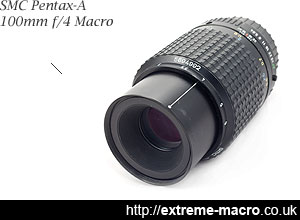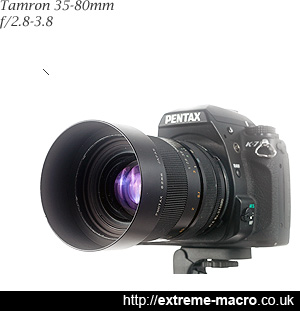Macro Lenses
by Johan J Ingles-Le Nobel
Last updated August 31, 2017
A macro lens is classically a lens capable of reproduction ratios greater than 1:1, although it often refers to any lens with a large reproduction ratio, despite rarely exceeding 1:1. Yes, it's nuts.
Thankfully though, it really is difficult to buy a very bad macro lens. Most macro lenses really are very good and it's not usually the quality of the lens that limits macro photographers.
SMC Pentax-A 100mm f/4 Macro, a dedicated macro lens. A very old and dated manual lens for the 35mm era, but the focus throw is large and the focusing silky smooth.
Macro photography is more widely accessible at a lower cost than it has ever been before - today's small-sensor digital cameras can rival the macro capabilities of a DSLR with a 'true' macro lens because of advances in sensor technology.
Macro vs. Telephoto
Unfortunately, nowadays, the term macro is more widely used to describe equipment with some sort of close-focusing capability rather than actual macro, and lenses with up to 1:4 magnification ratios (quarter life size) are often billed as having macro functionality. A 1:4 lens labelled macro is marketing bullshit.
Real macro lenses are specifically designed for magnification work, both optically and mechanically.
A 1:4 lens labelled macro is marketing bullshitOptically, macro lens optics are better in the close range focus area than far away towards infinity. A good macro lens also lets you focus close by whereas non macro lenses may have a minimum focus distance of 1m.
Mechanically, if you use manual macro lenses like I do, a good macro lens should have a long focus throw. In other words, the more twisting you have to do to focus the lens 3cm away from where you are currently focusing, the better.
This micro adjustment ability is important. Even if you use autofocus there will be times when you want to do this manually. Lastly, the reproduction ratio should be at least 1:1.
Macro lenses in MM
Macro lenses of different focal lengths find different uses. Under 60mm is a good focal length for product photography, small objects that can be approached closely without causing undesirable influence, and scenes requiring natural background perspective. 90-105mm works for insects, flowers, and small objects from a comfortable distance. 150mm+ is ideal for insects and other small animals where additional working distance is required.
Starting Out In Macro
Pentax K-7 with Tamron Adaptall SP 35-80 f/2.8-3.8 mounted, thought to be one of the highest quality zoom lenses ever produced by Tamron.
Macro photography has never been more popular than it is today, and many standard cameras now have some dedicated closeup facility. These make for a great introduction to macro photography without incurring the expense of purchasing a high end DSLR system.
Compact digital cameras and small-sensor bridge cameras, have a deep depth of field which is an advantage for macro work. The high pixel density and resolving power of their sensors enable them to capture very high levels of detail at a lower reproduction ratio than is needed for film or larger DSLR sensors, usually at the cost of greater image noise.
DSLR Macro Lenses
a fast aperture 1:1 macro lens with great optical performance will command the highest pricesIn terms of DSLRs, a fast aperture 1:1 macro lens with great optical performance will command the highest prices. Look for a lens that is capable of focusing internally - a lens can focus without its inner barrel extending outwards. This prevents the lens inadvertently touching the subject, and reduces the likelihood of shadows from the lens being cast over the subject.
For the photographer using autofocus lenses, look for a focus limiter switch, which can be used to close off a part of the focus range that isn't required, allowing focus to be acquired sooner. Optical stabilisation can be useful if the body you're using lacks a sensor-based image stabilisation system such as the Pentax system, although if you're using the lens on a tripod for macro work, it's obviously best to turn stabilisation off.
Related Articles







